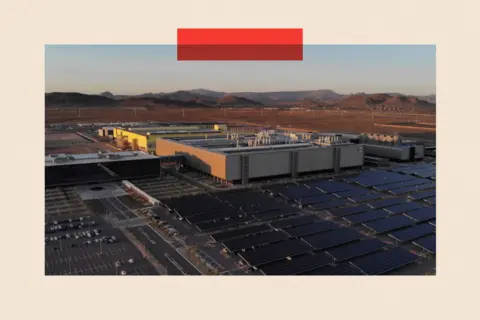The Hidden Arizona Factory Highlighting Contradictions in Trump’s Economic Agenda
In the arid landscape of Arizona, a groundbreaking facility is taking shape that promises to influence the global economy and technological landscape significantly. This ambitious project represents a historic venture for the United States, as the Taiwan Semiconductor Manufacturing Company (TSMC) works to establish a state-of-the-art semiconductor manufacturing plant near Phoenix. TSMC, which currently produces 90% of the world’s advanced semiconductors, is set to invest billions in this initiative to mitigate the looming challenges posed by tariffs on imported chips.
Dubbed “Fab 21,” TSMC’s new facility is enveloped in secrecy, demanding strict protocols that disallow personal devices or written materials to prevent the leakage of sensitive information. The process of semiconductor production housed within is among the most intricate in the world, involving precise technology and monumental investment. The chips produced here will be pivotal not just for tech giants like Apple and Nvidia, but also for the future of computing and artificial intelligence.
Trump’s Economic Vision
Former President Donald Trump often cites TSMC’s investment in Arizona as a success story of his “America First” policy. His administration promoted foreign manufacturers relocating to the U.S. to avoid tariffs, and he regards TSMC’s significant investment as a testament to this strategy. “We gradually lost the chip business, and now it’s almost exclusively in Taiwan. They stole it from us,” Trump remarked, emphasizing the geopolitical stakes involved.
The rapid development of this Arizona factory dovetails with broader economic tensions regarding Taiwan, which China claims as its territory. Taiwan’s dominance in semiconductor production is viewed as a vital strategic asset, particularly amid the threat of military action from China. The pandemic exposed vulnerabilities in supply chains, prompting a reevaluation of reliance on a single geopolitical region for critical technology.
World-Class Manufacturing and Environmental Standards
During a recent tour of the Arizona facility led by Greg Jackson, one of the plant managers, it became evident that the manufacturing environment is engineered to meet unrivaled cleanliness and precision standards. The factory replicates TSMC’s Taiwanese facilities, using advanced technologies to create microchips with transistor sizes measured in nanometers. Jackson remarked, “These facilities are probably some of the most advanced and complicated in the world.”
In the “Gowning Building,” staff dress in protective gear before entering cleanroom environments designed to eliminate pollutants. Each silicon wafer emerges from a meticulously controlled process involving thousands of steps, such as the cutting-edge technique of extreme ultraviolet lithography, essential for crafting the complex structures of modern chips.
Global Implications and Supply Chain Dynamics
Despite TSMC’s expansion plans in the U.S., the company acknowledges the global nature of the semiconductor supply chain. This venture relies on materials and equipment sourced from various countries, making it untenable to shift production entirely to the United States overnight. TSMC Arizona President Rose Castanares pointed out, “The semiconductor supply chain is global… it’s very difficult to unwind that whole thing very quickly.”
As the world grapples with evolving semiconductor needs, policies to isolate technology from China are being tested. American efforts aimed at limiting China’s access to advanced semiconductors form a central aspect of both the Trump and Biden administrations’ strategies. However, challenges remain as technological advancements in China continue at a rapid pace.
Table: Key Facts about TSMC’s Arizona Facility
| Feature | Details |
|---|---|
| Location | Arizona, USA |
| Investment | Over $100 billion |
| Chip Size | 4 nanometers |
| Transistors per Wafer | 10 to 14 trillion |
| Key Customers | Apple, Nvidia |
As TSMC’s Arizona factory begins operations, it stands as a crucial element in the quest for technological supremacy and robust supply chains amid geopolitical turbulence. Whether it will fulfill its promise remains to be seen, but it undoubtedly marks a significant chapter in the ongoing saga of global technology competition.

